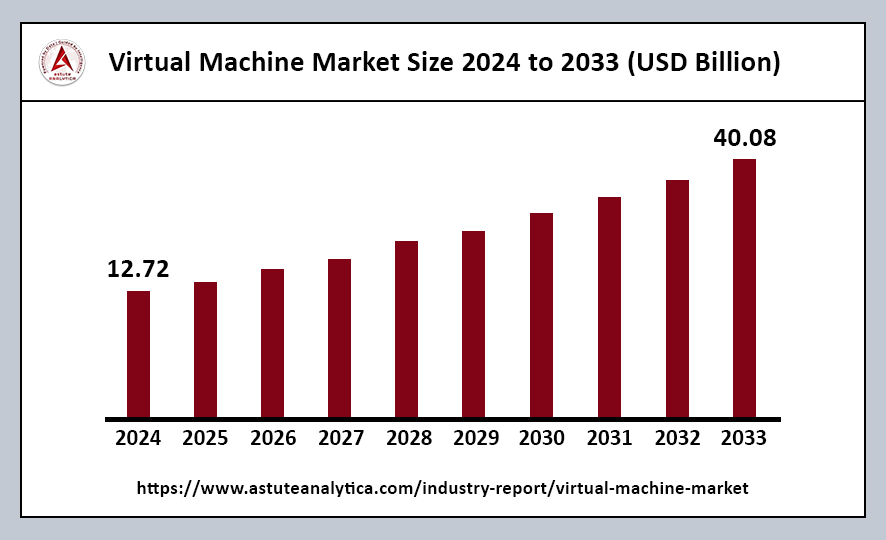The global virtual machine market was valued at US$ 12.72 billion in 2024 and is projected to reach US$ 40.08 billion by 2033, reflecting a Compound Annual Growth Rate (CAGR) of 13.6% during the forecast period from 2025 to 2033.

Virtual machines (VMs) continue to be popular due to their versatility across a wide range of use cases, including software testing, development, and cloud computing. Their adaptability makes them an essential tool for organizations looking to optimize their IT operations. The market for virtual machines is projected to grow significantly in the coming years. This anticipated growth is driven by the increasing demand for virtualization solutions across various industries, as businesses recognize the benefits of implementing VMs in their operations.
Virtual Machines Market Key Takeaways
- By Vertical, The BFSI (Banking, Financial Services, and Insurance) sector is leading the virtual machine market, commanding over 27% market share.
- In terms of organization size, small and medium-sized enterprises (SMEs) control a remarkable 73% share of the virtual machine market.
- When examining the market by type, system virtual machines hold a substantial 64% market share.
Regional Analysis
North America’s Leadership in the Virtual Machine Market
North America leads the virtual machine market with over 37% market share, driven by its advanced IT ecosystem and robust infrastructure investments. This strong foundation allows organizations to leverage virtualization technologies for enhanced operational efficiency.
- Deployment of Concurrent Virtual Environments: Regional data centers in the United States have successfully deployed up to 10 concurrent virtual environments per system, resulting in significant operational resilience. This capability not only maximizes resource utilization but also ensures that businesses can maintain service continuity even during peak demands or unexpected disruptions.
- Competitive Landscape in the United States: The United States is at the forefront of the competitive landscape within the virtual machine market. Industry leaders such as VMware, Microsoft, Oracle, IBM, and Citrix Systems are powering extensive virtualization deployments in major metropolitan centers. Their innovations and solutions are instrumental in shaping the future of virtualization in the region.
- Evolving Market Dynamics: Broad market dynamics in North America’s virtual machine sector continue to evolve as academia, industry, and government collaborate on innovative virtualization strategies. This collaboration fosters the development of cutting-edge solutions that address the unique challenges faced by organizations, ensuring that North America remains a leader in the global virtualization market.
Significant Growth in the Asia Pacific Region
The Asia Pacific region is experiencing significant growth in the virtual machine market. This expansion can be attributed to technological advancements, increased digitization efforts, and evolving business needs that demand more flexible and efficient IT solutions.
- Influence of Technological Advancements: Market dynamics in Asia Pacific are heavily influenced by ongoing technological advancements. These innovations are enabling organizations to leverage virtualization technologies, allowing for better resource management and improved operational efficiencies. As businesses strive to stay competitive, adopting these technologies becomes a priority.
- Increased Cloud Adoption Across Enterprises: The region has also witnessed a marked increase in cloud adoption across enterprises of all sizes. Organizations are increasingly recognizing the benefits of cloud-based solutions, which offer scalability and cost-effectiveness. This shift is particularly evident with the growing popularity of Infrastructure as a Service (IaaS), Platform as a Service (PaaS), and Software as a Service (SaaS) models.
- Growing Demand in Cloud Environments: As more organizations embrace IaaS, PaaS, and SaaS solutions, there is a corresponding rise in demand for virtual machines (VMs) within cloud environments. This trend underscores the critical role that virtualization plays in supporting cloud strategies and enhancing the overall agility and responsiveness of businesses in the Asia Pacific region.
Growth in the Virtual Machine Market in Europe
Europe is witnessing notable growth in the virtual machine market due to an increased emphasis on digital transformation, remote work, and the need for efficient IT infrastructure. These factors are prompting organizations across the region to reevaluate their operational strategies and invest in virtualization technologies.
- Adoption of Virtualization Technologies: Organizations in Europe are adopting virtualization technologies to enhance flexibility, optimize resource utilization, and improve overall business continuity.
- Cloud Adoption and Demand for Secure Solutions: The push for cloud adoption, combined with the rising demand for secure and scalable computing solutions, has significantly driven the expansion of the virtual machine market in Europe. This trend reflects a broader movement toward technological advancement and modernization across various industries in the region.
- Broader Technological Trends: The growth of the virtual machine market in Europe is indicative of a larger trend of technological evolution. As industries continue to embrace digital solutions, the demand for efficient and adaptable IT infrastructure will likely persist, further solidifying the role of virtualization in supporting business objectives throughout the region.
Top Trends Escalating the Virtual Machines Market
AI Integration Enhancing Performance: The integration of artificial intelligence (AI) is significantly enhancing performance across virtual machine environments. This proactive approach improves the efficiency of virtual machines and enables better workload management, resulting in enhanced overall performance.
Cloud-Based Virtualization Methods Rapidly Evolving: As technology advances, cloud-based virtualization methods are rapidly evolving to optimize resource utilization. This evolution allows enterprises to dynamically allocate resources based on real-time needs, reducing waste and lowering costs. Moreover, cloud service providers are continually enhancing their offerings, providing businesses with increasingly sophisticated tools for managing virtual environments, ensuring they can adapt quickly to changing demands.
Edge Computing Deployments: The rise of edge computing is further boosting the deployment of virtual machines for distributed workloads. Virtual machines deployed at edge locations can efficiently handle data from IoT devices and other sources, allowing enterprises to manage workloads effectively across various geographical areas. This distributed approach ensures that businesses can maintain high levels of service and responsiveness, even in environments with fluctuating demands.
Rapid Cloud Adoption: The rapid adoption of cloud technologies is driving increased integration of virtual machines, enabling enterprises to become more agile. As organizations migrate to the cloud, they are discovering the benefits of virtualization, which allows for quick provisioning and scaling of resources. This agility enables businesses to respond swiftly to market changes, deploy new applications faster, and support remote workforces seamlessly.
Data Center Modernization: Ongoing data center modernization initiatives are fueling the demand for versatile virtual machine solutions. As organizations seek to upgrade their infrastructure to accommodate modern workloads, the flexibility and scalability offered by virtual machines become increasingly appealing. Businesses are investing in technologies that allow them to create hybrid environments, combining on-premises and cloud resources effectively.
Emerging Hybrid Cloud Strategies: Emerging hybrid cloud strategies are driving additional virtual machine deployments as organizations seek to balance the benefits of both private and public cloud environments. This flexibility ensures that enterprises can take advantage of the best features of both cloud models, enhancing their ability to innovate and grow in today’s dynamic market landscape.
Virtual Machine Market Segmentation
By Vertical
In the virtual machine market, the BFSI (Banking, Financial Services, and Insurance) sector is leading the way. This dominance is largely due to the sector’s need for robust security, high availability, and strict regulatory adherence. As a result, virtualization has become a crucial component in the operational strategies of financial institutions. To enhance their operational efficiency, financial institutions now typically segment critical operations by deploying an average of 6 dedicated virtual processing units per branch. This strategic approach has allowed banks and insurance firms to significantly reduce fault recovery time, cutting it down by nearly 20 minutes for each service interruption.
By Organization Size
Small and medium-sized enterprises (SMEs) are controlling over 73% of the virtual machine market, largely due to their growing popularity as a practical solution to overcome cost and infrastructure constraints. This significant market share highlights the increasing reliance of SMEs on virtualization technology to enhance their operational efficiency. Typically, SMEs deploy between 4 and 6 virtual instances per server. This approach allows for the effective isolation of various functions, ranging from accounting systems to customer relations.
By Type
System virtual machines have become the backbone of modern enterprise IT by enabling full hardware emulation through Type 1 hypervisors. This innovative approach in the virtual machine market supports the concurrent operation of multiple operating systems on a single physical server. In many advanced deployments, companies have configured as many as 8 independent operating environments on one host. This capability maximizes resource utilization and enhances flexibility and scalability, allowing businesses to optimize their IT infrastructure to meet diverse operational needs.
Virtual Machines Market Recent Developments
- Hyperliquid Bug Bounty Program Launch: In February 2025, Hyperliquid, a layer-1 blockchain platform, launched a bug bounty program alongside the rollout of HyperEVM, its general-purpose Ethereum Virtual Machine (EVM).
- Red Hat OpenShift Virtualization Engine Announcement: In January 2025, Red Hat, one of the world’s leading providers of open-source solutions, announced the general availability of the Red Hat OpenShift Virtualization Engine, a new edition of its OpenShift platform tailored specifically for managing virtual machines (VMs).
- Solana Optimistic Network NFT Sale: In January 2025, the Solana Optimistic Network, or SOON, raised $22 million through an NFT sale as it prepared to launch its mainnet. Unlike other Ethereum scaling layers, SOON uses the Solana Virtual Machine, making it unique among Ethereum scaling layers.
- Microsoft AI Infrastructure Advancements: In November 2024, Microsoft enhanced its AI infrastructure offerings with new VMs, cooling, and power delivery technology. These advancements encompass everything from AI accelerators, computer chips, and liquid cooling to data integrations and flexible cloud deployments.
- Microsoft Azure ND H200 v5 Series Launch: In October 2024, Microsoft launched its latest Azure virtual machines optimized for AI supercomputing, the ND H200 v5 series. These VMs are now generally available and will manage the growing complexity of advanced AI workloads.
Top Companies in the Virtual Machine Market:
- Amazon Web Services, Inc.
- Cisco Systems
- Citrix
- Dell Technologies
- Google Cloud
- Hewlett Packard Enterprise (HPE)
- Huawei Technologies Co. Ltd.
- Intel Corporation
- International Business Machines Corporation
- Microsoft
- Nutanix
- Oracle Corporation
- Parallels Inc.
- Proxmox Server Solutions GmbH
- Red Hat, Inc.
- VMware
- Other Prominent Players
Market Segmentation Overview:
By Type
- System Virtual Machine
- Process Virtual Machine
By Organization Size
- Large Enterprises
- SMEs
By Vertical
- BFSI
- Telecommunications & ITES
- Government & Public Sector
- Healthcare & Life Sciences
- Others
By Geography
- North America
- Europe
- Asia-Pacific
- Latin America
- Middle East and Africa
Source: https://www.astuteanalytica.com/industry-report/virtual-machine-market














